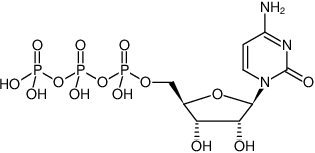CTP - Solution
100 mM Sodium salt solution
Cytidine 5'-triphosphate, Sodium salt
| Catálogo Nº | Apresentação | Preço (R$) | Comprar / Observação |
|---|---|---|---|
| NU-1011 | 1 ml (100 mM) | Sob demanda | Adicionar ao Carrinho |

For general laboratory use.
Envio: shipped on gel packs
Condições de armazenamento: store at -20 °C
Short term exposure (up to 1 week cumulative) to ambient temperature possible. If stored as recommended, Jena Bioscience guarantees optimal performance of this product for 12 months after date of delivery.
Validade: 12 months
Fórmula molecular: C9H16N3O14P3 (free acid)
Peso molecular: 483.16 g/mol (free acid)
CAS#: 36051-68-0
Número CE: 252-849-3
Pureza: ≥ 99 % (HPLC)
Forma: clear aqueous solution
Concentração: 100 mM ±2 %
pH: 8.0 ±0.2 (22 °C)
Propriedades espectroscópicas: λmax 271 nm, ε 8.9 L mmol-1 cm-1 (Tris-HCl pH 7.0)
Formulários:
Physiological role in coronary artery disease[1]
Physiolocal role in lipid metabolism[2]
Physiological role in farnesol induced apoptosis[3]
Descrição:
Ultrapure CTP supplied as clear aqueous solution.
Specific Ligands: CTP synthase[4] Phosphocholine cytidyltransferase alpha[2] Ligand for purinergic receptors: P2Y6[5] P2X3[6]
Referências selecionadas:
[1] Lui et al. (2010) Evaluation of CT perfusion in setting of cerebral ischemia:patterns and pitfalls. American Journal of Neuroradiology 31:1552.
[2] Luoma (2010) Gene activation regresses artheriosclerosis, promotes health, and enhances longevity. Lipids in health and disease 9:67.
[3] Joo et al. (2010) Molecular mechanisms involved in farnesol-induced apotosis. Cancer letters 287:123.
[4] Cabeen et al. (2010) A metabolic assembly line in bacteria. Nature Cell Biology 12:731.
[5]Jayasekara et al. (2013) 4-Alkoxyimino-cytosine nucleotides: tethering approaches to molecular probes for the P2Y6 receptor. MedChemComm. 4 (8):1156.
[6]Garzia-Guzman et al. (1997) Molecular characterization and pharmacological properties of the human P2X3 purinoreceptor. Mol. Brain Res. 47 (1):59.
Spangler et al. (2011) Interaction of the diguanylate cyclase YdeH of Escherichia coli with 2', (3')-substituted purine and pyrimidine nucleotides. J. Pharmacol. Exp. Ther. 336 (1):234.
